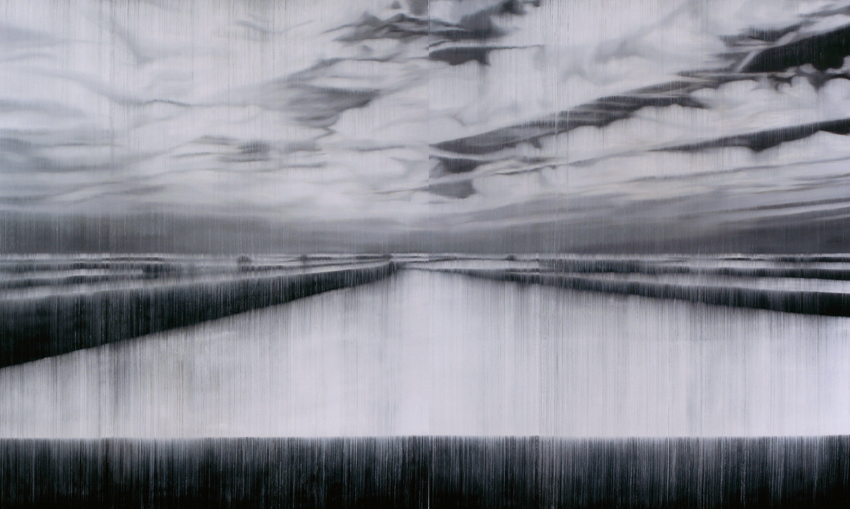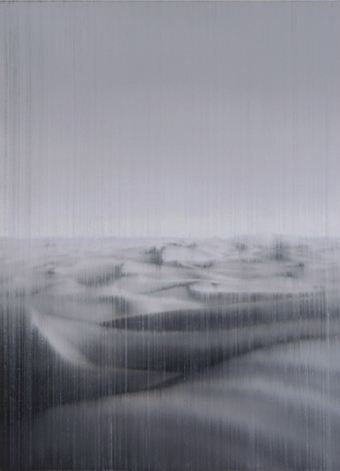
Lines of Flight-to the Sahara op.328
2010, 195.0cmx320.0cm, oil on canvas
private collection
photo:Asa
At the Dunes of Merzouga
SUGAWARA Takeshi (Art critic)
|
The most evident feature in Akihito TAKUMA's recent work, as it has always been, would be the innumerable lines running from top to bottom. It can be interpreted both as an attempt to sweep away the image, which has been burnt into one's vision, or as a reconfirmation of the ambiguous, uncertain legibility. Drawing lines: an irretraceable act, denies the coherence of the expressive subject himself. In this piece of work, Takuma shifted his vision to the Sahara, from suburban cities and pastoral scenes. The artist's strong orientation towards vertical lines are carefully linked to the ripple marks on the dunes which never keep their original state, and to the horizontal lines and the perspective of the oases scattered in the suburbs of Erfoud. Tempted by the smooth texture of the sand, and the sea fossils hidden under the dunes, viewers' vision would be forced downward and may fade out. On the other hand, one may find 'Water Lilies', the masterpiece of Monet, projected onto the retina. The lines have an obvious function as a screen, intervening between the object and the artist staring into it. In a broad sense, it can be interpreted as a space, or a film of a space, which exists to define the objects. It can be hypothesized that the visible, touchable 3 dimensional space is made of a super-thin- film, and its basic structure is of a hexagonal shape, which keeps expanding into a honeycomb or a tortoise shell pattern. With this hypothesis, it can be assumed that TAKUMA's lines would show some tendency towards other directions, beyond his simple, line- oriented style. A series of "Lines of Escape" has a close similarity to " Ordinary Landscape" (Museum of Contemporary Art Tokyo 1962), a piece of work by Gaku ONOGI, rather than A. Giacometti's methodology that doesn't only pursue the object in a phenomenological sense, but, pursue its existence profiled against the background after many eliminations. Just like Gaku ONOGI painted a series of landscapes with visible brush strokes, after he had felt fed up with his own work: the figure and the ground so diagrammatic, and flown to France, I assume, that the series by Akihito TAKUMA could show his liberation from the Spanish realism which was so popular in the time he was an art student in Spain. Was the dry Moroccan climate foreign to the transient traveller? It seems to be a qLocal Languagerpeculiar to the island country, that Gaku ONOGI and Akihito Takuma's wet, monochrome space is representing. Whereas the spatial concept of Ahmed El Hayani (from Casablanca), a scholarship student of France I met by accident in Quartier Pigalle in Paris at the beginning of May, was aqCommon Languager. |

Lines of Flight-to the Sahara op.324
2010, 100.0cmx72.7cm, oil on canvas
Public collection: Color Museum, Tokyo, Japan

Lines of Flight-to the Sahara
op.327
2010, 195cmx700cm, oil on canvas
Kinokuniya Gallery, Tokyo (Jul.1-6, 2010)

Lines of Flight-to the Sahara
op.321
2010, 194cm~162cm, oil on canvas
private collection

Lines of Flight-to the Sahara
op.322
2010, 194cm~162cm, oil on canvas
private collection
Kinokuniya Gallery, Jul.1 - Jul.6, 2010
back to Photo
go home
comment please!! takuma_aki@yahoo.co.jp
Biography|Photo|Message|Link
(c) Art works and text copyright Akihito Takuma